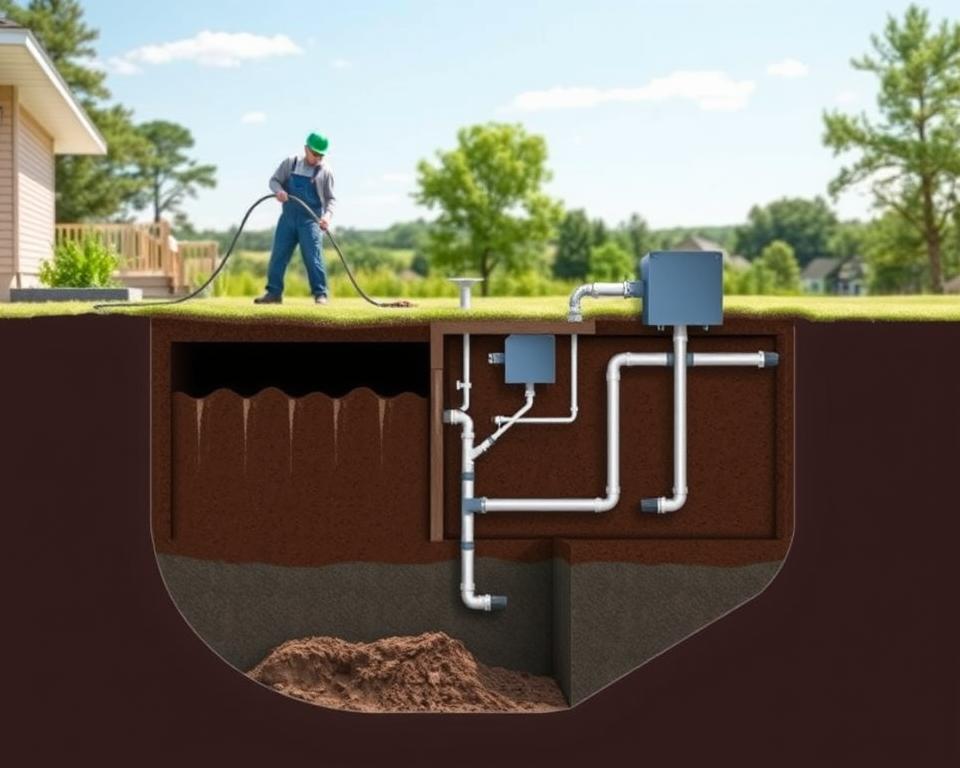Septic Aerator Pump: Must-Read Guide for Homeowners
Have you ever wondered what boosts your aerobic Septic setup’s efficiency? The aeration Pump is the often-overlooked champion crucial for your system. With this resource, homeowners will get useful insight on the device’s function. It’s critical for a healthy, optimized Septic tank.
Grasping the value of a Septic tank air Pump can improve your Septic system’s performance using septic tank cleaning companies near me. It also secures your property’s value and surrounding ecosystem. The resource below will introduce All in Sanitation, a reputable Septic industry leader. They’re prepared to serve your Septic aerator Pump needs.
Critical Findings
- The Septic air Pump is indispensable for oxygen-based Septic setups.
- Servicing your Septic system air Pump can optimize overall system function.
- Regular checks extend the service life of your Septic tank air Pump.
- Opting for the correct Septic aerator Pump is key for maximum operation.
- All in Sanitation provides expert services for Septic air Pump needs.
Breaking Down Aerobic Septic Setups
Aerobic Septic systems present a superior waste treatment method by employing oxygen. This system features aerobic bacteria flourishing in well-oxygenated environments. These bacteria are more efficient in breaking down organic matter. With the help of Septic aerator Pumps, these systems provide a consistent oxygen supply, accelerating the waste decomposition process.
These systems stand out in reducing sludge buildup, because of the activity of aerobic bacteria. This drop in solid waste means minimal cleaning and tank Pump-outs is needed. Additionally, they successfully handle wastewater, producing barely any odor. This produces a better environment for homeowners and the community alike.
To ensure these systems operate smoothly, it’s essential to recognize the key Septic system components. These include the Septic tank, treatment chamber, and effluent Pump. Each component serves a key function, especially the air Pump. It forces oxygen into the tank, vital for the aerobic bacteria’s efficiency.
Importance of the Septic Air Pump
The Septic air Pump is crucial in the operation of aerobic Septic systems. It acts as the system’s “oxygen source,” supplying the necessary oxygen mandatory. This oxygen allows aerobic bacteria to operate efficiently and break down waste quickly. If the Pump fails, the system’s performance drops, leading to sludge increase and possible odors.
Such issues can interfere with Septic system operations and pose environmental hazards. By understanding how essential the Septic air Pump is, homeowners can respond ahead of time. They can keep its top function through regular maintenance. This avoids failures, prevents costly repairs, and preserves the aerobic system’s well-being.
Top Advantages of Using a Septic Air Pump
Employing a Septic air Pump markedly increases the capability of Septic systems. Septic air Pumps are vital as they accelerate the processing of waste. This is realized by oxygenating the treatment process, promoting aerobic bacteria growth. These bacteria are vital for effective waste treatment.
They’re also helpful in minimizing foul smells. Due to more active aerobic processes, waste decomposes faster, thus lessening odors. This provides a fresher environment for homeowners.
Another noteworthy benefit is the cut in sludge collection. Consequently, tanks need less frequent Pumping, saving both money and time. Greater processing not only reduces spending but also extends the lifespan of the drain field.
Proper care of these Pumps properly means reduced repair costs and satisfying regulatory standards. Thus, the pluses of Septic air Pumps go beyond being for homeowners. They also benefit environmental health by improving waste management practices.
| Benefit | Description |
|---|---|
| Fast Waste Breakdown | Heightened aerobic activity quickens the decomposition process. |
| Minimized Odor Emissions | Superior treatment efficacy creates fewer odors. |
| Reduced Sludge Buildup | Minimal Pumping and maintenance are necessary. |
| Extended Drain Field Life | Better treatment equals a healthier drain field. |
| Cost Savings | Lower risk of repairs and regulatory compliance cost. |

Finding a Suitable Septic Air Pump
Selecting the correct Septic air Pump is essential for an well-running aerobic system. Homeowners must consider various factors for the perfect selection. The size of the tank and the airflow requirements matter greatly the Pump’s effectiveness.
To make an informed choice, it’s helpful to know the air Pumps available. There are mainly two types: diaphragm Pumps and rotary vane Pumps. Each delivers unique benefits, which should be matched with your home’s unique requirements and usage pattern.
Energy use also is a factor. Choosing a Pump that reduces energy use while achieving the needed airflow can yield noticeable cost cuts. Guidance from All in Sanitation experts can be very helpful. They verify the Pump you choose meets your system’s requirements exactly.
Typical Classes of Septic Air Pumps
Homeowners can choose intelligently by knowing the multiple Septic air Pumps available. There are mainly two types: diaphragm Pumps and rotary vane Pumps. Each has its unique functions and benefits.
Diaphragm Pumps, famous for their quiet operation, are popular for residential Septic systems. They deliver energy efficiency while supplying consistent airflow. Their constant performance fits smaller systems, appealing to many homeowners.
Rotary vane Pumps, however, are ideal for bigger or commercial systems. These Pumps provide higher capacity, essential in handling bigger loads. Their strong build delivers efficient operation in heavy-duty Septic systems.
| Type of Pump | Best Use | Advantages |
|---|---|---|
| Diaphragm Pumps | Residential Systems | Quiet operation, energy-efficient, reliable air flow |
| Rotary Vane Pumps | Larger or Commercial Systems | Powerful performance, high capacity, durable construction |
Knowing the distinctions in Septic air Pumps is vital for upgrades or replacements. Each Pump type delivers particular attributes to fulfil various needs. This guarantees peak performance for any system.
Signs You Might Need a Septic Air Pump Replacement
Homeowners must look out for Pump failure signs in their Septic systems. Some symptoms suggest the need for a Septic air Pump replacement. These help maintain smooth operation. Catching these promptly avoids bigger issues.
Signs of potential problems include:
- Unusual noises from the Pump, like rattling or buzzing, might signal internal damage.
- A clear lack of air output reveals the Pump isn’t functioning properly, impacting efficiency.
- Regular electrical problems, such as blown fuses or voltage drops, could point to overloading.
- Visible damage on the Pump unit, with splits or leaks, needs quick action.
- Unpleasant odors in the yard often signal a compromised Pump, showing ineffective effluent aeration.
Detecting these signs early prevents pricey restoration or total system failure. Carrying out regular checks helps identify these issues. It also shows if you require a new Septic air Pump.
Upkeep Advice for Your Septic Air Pump
For an effective Septic air Pump, regular maintenance is vital. This ensures that that your system works smoothly. Homeowners can apply several simple care strategies for optimal results.
Bi-annually, conduct a detailed inspection for wear or damage. It is also essential to swap out the filters as advised. This stops clogs that could hamper efficiency.
The Pump should sit on a stable base to reduce vibrations, which could damage it over time. A protective cover is important too. It protects against debris and water, preserving the Pump’s functionality.
Good upkeep can considerably lengthen the life of your Pump. In turn, this enhances the Septic system’s performance as a whole.
| Maintenance Task | Frequency | Benefits |
|---|---|---|
| Inspect Pump for damage | Every 6 months | Finds faults promptly |
| Replace filters | As needed | Enhances operation |
| Check surface stability | Annually | Protects components |
| Clear debris around Pump | Monthly | Prevents clogs |
Installing Your Septic Air Pump
Correct installation of your Septic air Pump is critical for its optimal operation. First, choose a stable, moisture-free area for placement. The chosen spot should securely accommodate the Pump’s weight with ease.
To reliably set up your Pump on your own, follow the following guidelines:
- Collect all necessary items, including the Pump, a power source, and hose fittings.
- Check the manufacturer’s guidelines before beginning your installation.
- Confirm every connection is proper to stop air leaks that hurt performance.
- After assembly, run a test to confirm the system works as intended.
If the installation process appears difficult, reach out to All in Sanitation. Their professionals can avoid common errors, making sure your setup meets necessary safety requirements.
Reasons to Select All in Sanitation for Your Septic Air Pump Requirements
When picking a Septic service provider, the choice is significant. All in Sanitation separates itself by supplying dependable Septic air Pumps. They satisfy different homeowner requirements with a extensive selection of high-grade products. This guarantees customers discover an appropriate match for their Septic systems.
What truly separates All in Sanitation is in addition to their large product lineup. Their devotion to excellent customer service is also critical. Homeowners get professional guidance, guiding them towards trusted Septic solutions. This collaboration is essential to adapt each solution to match specific needs.
All in Sanitation also emphasizes aftercare to ensure lasting satisfaction. Their commitment goes beyond the initial sale. They supply ongoing support to ensure Septic systems operating efficiently for the long term.
Expense Overview for Septic Air Pumps
Knowing the price factors connected with Septic air Pumps is essential for homeowners operating aerobic Septic systems. To start, one faces the initial cost, which includes the Pump and needed accessories. Installation expenses vary, based on the system’s complexity and any modifications required.
Ongoing upkeep forms an additional cost layer. Routine checks can fend off bigger issues, ultimately leading to savings. Homeowners should set aside funds for Septic maintenance to retain the Pump’s effectiveness and longevity. Such planning helps dodge expensive repairs later on, highlighting the benefit of proactive maintenance.
| Cost Component | Average Cost Range |
|---|---|
| Septic Air Pump | $500 – $1,200 |
| Installation | $300 – $800 |
| Annual Maintenance | $150 – $400 |
| Potential Repair Costs | $1,000 – $5,000 |
Breaking down Septic air Pump expenses into specific parts helps homeowners in financial preparation. This detailed approach guarantees the system’s consistent operation and their confidence.
The Bottom Line
For homeowners with aerobic Septic systems, maintaining Septic tanks is essential. The proper Septic air Pump improves waste processing and increases your system’s life. Sticking with consistent service and quickly fixing issues prevents costly fixes and disruptions.
Choosing a Septic air Pump demands consideration. This guide highlighted how to decide intelligently about installation and replacement. With All in Sanitation’s guidance, you can tackle your Septic systems’ complexities assuredly.
Maintaining your Septic air Pump improves your system’s operation and life span. It guarantees a reliable and successful operation over time. Remember, your home’s wastewater management relies heavily on ongoing maintenance.
